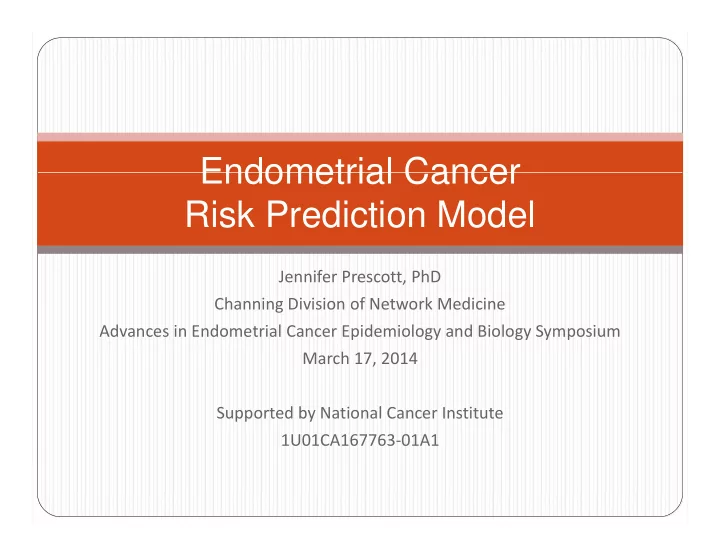

Endometrial Cancer Endometrial Cancer Risk Prediction Model Jennifer Prescott, PhD Channing Division of Network Medicine Advances in Endometrial Cancer Epidemiology and Biology Symposium March 17, 2014 Supported by National Cancer Institute 1U01CA167763-01A1
Utility of risk prediction models Utility of risk prediction models Aid in clinical management Aid in clinical management Identify high risk populations for intervention studies Identify high risk populations for intervention studies Understand biologic process of carcinogenesis Understand biologic process of carcinogenesis 2
Exposures change rate of tissue aging Endometrial cancer Colorectal cancer e/100,000 e/100,000 Incidence rate Incidence rate Breast cancer Ovarian cancer 0,000 0,000 ence rate/100 ence rate/100 Incid Incid Sources: Pike 1983 Nature 3 Pike 1987 J Chron Dise Pike 2004 Oncogene
Reproductive events in breast tissue aging aging Sources: Pike 1983 Nature 4 Pike 1987 J Chron Dise Pike 2004 Oncogene
Can we improve endometrial cancer p risk prediction by incorporating timing of exposures? of exposures? 5
Study population Study population Nurses’ Health Study (NHS) Nurses Health Study (NHS) Ongoing prospective cohort 121,700 female registered nurses from 11 U.S. states 30-55 years of age at baseline in 1976 Biennial self-administered questionnaires NHS High follow-up rates 6
Detailed risk factor information Detailed risk factor information Type of female female hormones first reported NHS 7 http://www.channing.harvard.edu/nh
Case ascertainment Case ascertainment Self report incident diagnosis of endometrial cancer Self-report incident diagnosis of endometrial cancer Women were asked permission to obtain medical records Records reviewed by gynecologic oncologist or pathologist Histologic subtype Stage Grade Analysis restricted to medical-record confirmed invasive epithelial endometrial adenocarcinoma (Stages IA-IV) ith li l d t i l d i (St IA IV) 8
Exclusions at baseline (1978) Exclusions at baseline (1978) Cancer diagnosis (except non-melanoma skin cancer; Cancer diagnosis (except non melanoma skin cancer; N=4,180) Hysterectomy (N=24,542) Surgical or unknown menopausal status (N=13,673) Missing risk factor data (N 12 519) Missing risk factor data (N=12,519) Eligible women at baseline: 66 786 Eligible women at baseline: 66,786 9
Risk factors modeled Risk factors modeled Timing of reproductive events Timing of reproductive events Exogenous hormone use BMI in low vs. high estrogen environment (menopause/hormone use status) (menopause/hormone use status) Smoking Family history of endometrial cancer Personal history of diabetes or hypertension 10
Statistical analysis Statistical analysis Cox proportional hazards regression model Cox proportional hazards regression model Similar exclusions throughout follow-up g p Follow-up ended in June 1, 2010 Total incident cases diagnosed throughout follow-up: 648 11
Statistical analysis Statistical analysis Relative risks (RR) Relative risks (RR) Dichotomous variables: exp( β ) Continuous variables: exp( β *contrast in risk factor) C-statistic for overall discriminatory ability 12
Preliminary Results Preliminary Results 13
NHS endometrial cancer incidence rates rates 140 per 100,000 120 100 ears person-ye 80 80 dence rate p 60 40 Incid 20 0 35-39 40-44 45-49 50-54 55-59 60-64 65-69 70-74 75-79 Age categories (years) Age categories (years) 14
Duration of premenopausal period period Age at natural menopause RR 45 years of 1.00 age 50 years of 1.75 age g 15
Number and timing of births Number and timing of births Age at bi th births RR RR Nulliparous 1.00 20 0.68 20 23 20, 23, 0 53 0.53 26,29 29 29 0 48 0.48 16
Oral contraceptive use Oral contraceptive use Duration RR Never 1.00 10 years y 0.42 17
Current menopausal hormone use use Type, Duration RR Never 1.00 Oral E, 5 years , y 3.91 Oral E+P, 5 2.06 years years Other, 5 years 2.72 18
Body mass index (BMI) Body mass index (BMI) BMI RR 22 kg/m 2 1.00 30 kg/m 2 g 3.58 19
Pack years of smoking Pack-years of smoking Duration RR Never 1.00 20 pack- p 0.92 years 20
Medical history Medical history Condition RR None 1.00 Family history y y of endometrial cancer 1.48 Diabetes Diabetes 1.34 1.34 Hypertension 1.19 21
Comparison of discriminatory ability ability (Internal population) Pfeiffer et Current Difference P- al. model between value model models 0.766 0.793 -0.027 0.0000 (±0.009) (±0.009) (±0.007) 3 22
Limitations Limitations Source: http://www.win.niddk.nih.gov/statistics/#b 23 Source: Zbuk 2012 J Epidemiol Community Health
Conclusions Conclusions Incorporating timing of exposures may improve risk Incorporating timing of exposures may improve risk prediction of endometrial cancer Reproductive years may be particularly relevant period for intervention 24
Future directions Future directions Further explore relation with timing of birth Further explore relation with timing of birth Validate model in independent population (PLCO) Can we improve upon base model? p p Suggestive factors (e.g., coffee intake) Plasma biomarkers and/or genetic variants By histologic or molecular tumor subtype By histologic or molecular tumor subtype First dietary Blood Blood Buccal cell assessment t (1989 90) (1989-90) (2000 01) (2000-01) (2001 04) (2001-04) NHS 25 Tumor tissue
Acknowledgments Acknowledgments NHS PLCO Immaculata De Vivo Immaculata De Vivo Nicolas Wentzensen Nicolas Wentzensen Bernard Rosner Shelley Tworoger Shelley Tworoger Akila Viswanathan Participants of the Nurses’ Health Study 26
Recommend
More recommend